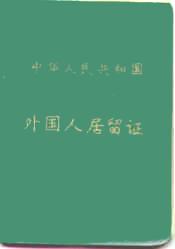
[an error occurred while processing this directive]

Every country has methods of identifying and keeping track of citizens and
foreign guests. For us in America, the primary identification method is
through a drivers license, a school ID, a Social Security card and for many
a bank card.

The red badge above identified my danwei as Kunming Teachers Training Institute. We didn't wear them all the time, but on special occasions when attending a regional meeting or event. The identification shown on this page is what I was identified by in China between 1988 and 1991. Because I used these cards everyday while I was in China, I kept them as some of my most prized momentos of my time in China. I was to have "turned them in" when I left the country, but some how that was overlooked. Alien workers in the United States have a "Green Card" - which for most, is no longer green - China has a similar system. I entered the country in February, 1988 to finish out a contract for a teacher that had to leave after one semester. For that first half year, I was issued a paper that was attached to my passport. It was only after I was issued a teaching contract for the next full year that I was issued a regular green card. It was renewed one year later for a second full contract. I usually kept this card, along with my U.S. passport locked in a safe in my apartment - except when I went on a trip outside of Kunming.
The school system was slightly different. Here they issued me about twelve cards, and I left a card for each book I took out. There was also an English "reading room" that was run by the department and it was opened up twice a week.
Most public and private buildings in China had gates with security on
duty. Certainly for the foreign teachers, there was not much of an
identification problem but for students coming and going on bicycles, there
could always be a question of identification of students that belonged to
the school.
At schools in the United States, we have student and faculty parking stickers for the cars. At my school in China, we were issued bicycle key identification tags. These were easy for security to spot as you dismounted your bike to walk it through the school gate. If you had the proper key tag for your school, you could enter with ease. If you had a key tag from another school or work unit - you might be asked to "sign in".
|
Kunming Teachers Training College
About - Kunming Teacher Training Institute Identification In China - 1988-1991
Yunnan Center of Foreign Language |
Added to the WWW 05-26-98
Updated 06-15-2002
Crossroads U.S.A. Mall | Consensus Inc. | Hy-Vee Stores | Santa Fe Railway | Investors Co-op
William R. Eubank
1632 Burcham Drive
East Lansing, Michigan 48823
United States of America